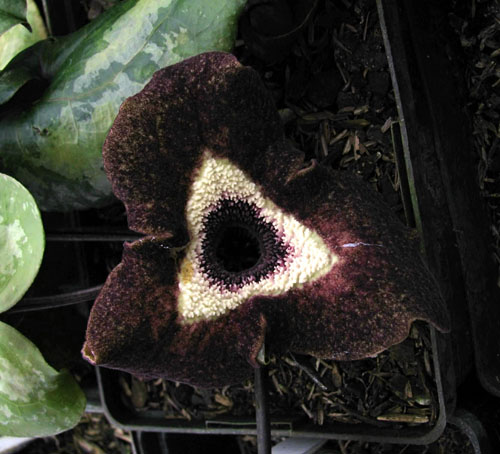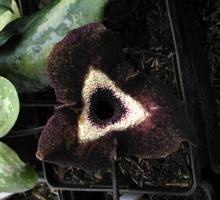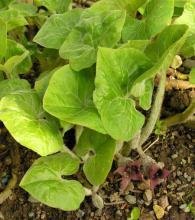


Wild ginger or Asarum is probably more well-known by wildflower enthusiasts or hikers than by gardeners. As a forest-floor wildflower, they are common throughout eastern North America, the Pacific Northwest, much of western Europe and east Asia. In fact, of the 70 or so species, the vast majority hail from east Asia. There are 8 species in North America and only one occurs in Europe.
Asarum belong to the Aristolochiaceae family. This family comprises only 5 genera, mostly from warm temperate regions. Asarum are generally low (under 15 cm) shade-loving species which may be deciduous or evergreen. Some authorities place the evergreen types into a separate genus called Hexastylis, but for simplicity, I’ll describe them all under Asarum.
The leaves are relatively large, produced either singularly or paired and are round to heart-shaped. The evergreen species are particularly treasured for their glossy textured foliage which is silver-veined or blotched on a few species. The flowers, which are produced in spring, are often hidden by the leaves and basically sit on the ground. Each flower is produced individually and have 3 petal-like sepals. While generally green to maroon in colour, they are quite interesting, albeit, sometimes malodorous. The blooms of the Asian species are particularly attractive. Plants slowly form colonies via underground rhizomes. Some, like the European A. europaeum or the American A. canadense, can be used as a ground-cover but the other species are slower to spread. The common name comes from the fact that the rhizome, when chewed, has a distinct ginger-like taste. In fact, their rhizomes can be used as a substitute for fresh ginger.
In the garden, provide these plants with dappled sunlight and a rich, organic soil that remains reasonably moist. Neutral to acidic pH seems to suit them best. They are wonderful companion plants for ferns, mayapples, woodland anemones, hepatica and jack-in-the-pulpits. Generally the Asian species are only hardy to zone 7; many of the American species are fine for zone 6 with the notable exception of A. canadense which can survive zone 2! The European species, A. europaeum, is the hardiest of the evergreen types, good to zone 4 or even zone 3 if properly insulated.
 For foliage effect, it’s hard to beat the American species native to the SE States, in particular A. arifolium, A. hartwegii, A. shuttleworthii and A. virginicum. These have evergreen leaves not unlike good variegated forms of Cyclamen hederifolium. If snow cover is guaranteed or under a good layer of leaves, these species can survive into the mildest parts of zone 5. Also with attractive foliage is the western American species A. marmoratum, but it is not reliable north of zone 7. There are also several Asian species with very attractively marked foliage. Among the best are A. splendens, A. maculatum (A. sieboldii), A. macranthum and A. magnificum. There are several others but they are difficult to find and rather expensive. These are also rated hardy to zone 7.
For foliage effect, it’s hard to beat the American species native to the SE States, in particular A. arifolium, A. hartwegii, A. shuttleworthii and A. virginicum. These have evergreen leaves not unlike good variegated forms of Cyclamen hederifolium. If snow cover is guaranteed or under a good layer of leaves, these species can survive into the mildest parts of zone 5. Also with attractive foliage is the western American species A. marmoratum, but it is not reliable north of zone 7. There are also several Asian species with very attractively marked foliage. Among the best are A. splendens, A. maculatum (A. sieboldii), A. macranthum and A. magnificum. There are several others but they are difficult to find and rather expensive. These are also rated hardy to zone 7.
As mentioned, the flowers are considered interesting at the very least. The European wild ginger and most of the North American species have maroon-purple flowers. Some like A. caudatum have larger flaring flowers with elongated sepals, thus are a little more attractive. The real floral winners are the Asian species. Some of these are intricately veined and marbled. The best of all might be A. maximum which has relatively large flowers that appear velvety black with a white ‘eye’. Like the Asian variegated species, these florally interesting species also fetch huge prices.

